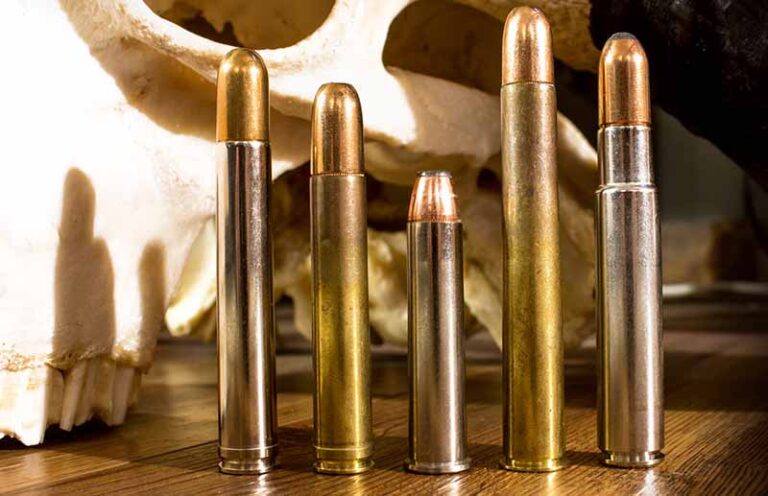
When it comes to big game hunting, there are few better tools for the job than .45-caliber rifle cartridges.
We were preparing for our first Cape buffalo safari—a seven-day jaunt to the famous Selous Reserve of southern Tanzania—busily working up handloads for the rifles. The game plan was that I’d be using my Winchester Model 70 in .416 Remington Magnum, and my father would be borrowing my .375 H&H Magnum.
As I pulled up to Ol’ Grumpy Pants’ house, where we have a very convenient 100-yard shooting range, he informed me he’d made a decision. “I’m borrowing a Winchester in .458 Win. Mag.; the components and dies are in the basement. Let me know when you’ve got it grouping.”
So began my trials and tribulations with the .458 Winchester Magnum, the first of a number of .45-caliber stopping rifle cartridges that would cross my path during the next 15 years.
Prior to this, my experience had been limited to the .45-70 Government, as my dad had purchased a centennial Model 1886 Browning when I was young, and I’d helped him develop a beefy handload for a bison hunt in South Dakota in ’03. That rifle, with its curved steel butt plate culminating in two lovely sharp points, was unforgettable from the bench, as the velocities broke 1,800 fps and then 1,900 fps with 400-grain bullets.
But every journey begins somewhere, and my experience with .45-caliber rifles has certainly grown over the years. Let’s take a look at the vast lineup of cartridges that deliver the .458-inch-diameter bullets, their history and applications.
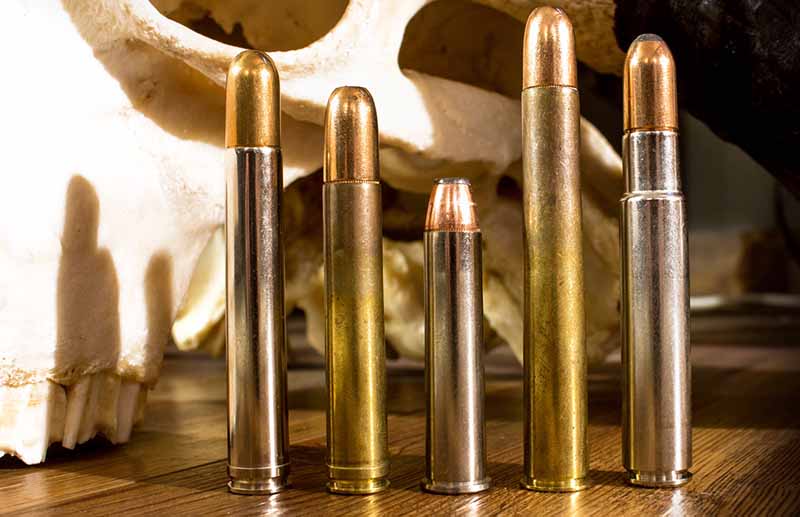
The .45-70 Government
As American as apple pie, the .45-70 Government represents the first American .45-caliber rifle cartridge. Developed in 1873 for use in the famous “Trapdoor” Springfield rifle, the .45-70-405 (as named by the U.S. Army) would use a .458-inch-diameter bullet of 405 grains, over a 70-grain charge of black powder. This cartridge would replace the .50-70 Government, and despite the fact that its trajectory pales in comparison to many modern cartridges, it remains a favorite for many hunters and shooters.
With a case measuring 2.105 inches, a rim diameter of .608 inch and a body diameter of .505 inch, the rimmed case gave good extraction from the single-loaders and the later lever rifles chambered for it. The original loads—using pure lead bullets—would obtain a muzzle velocity of roughly 1,350 fps with all the power needed to hunt any of the game animals on the North American continent, albeit longer shots would pose an issue due to the extreme arc of the .45-70’s trajectory.
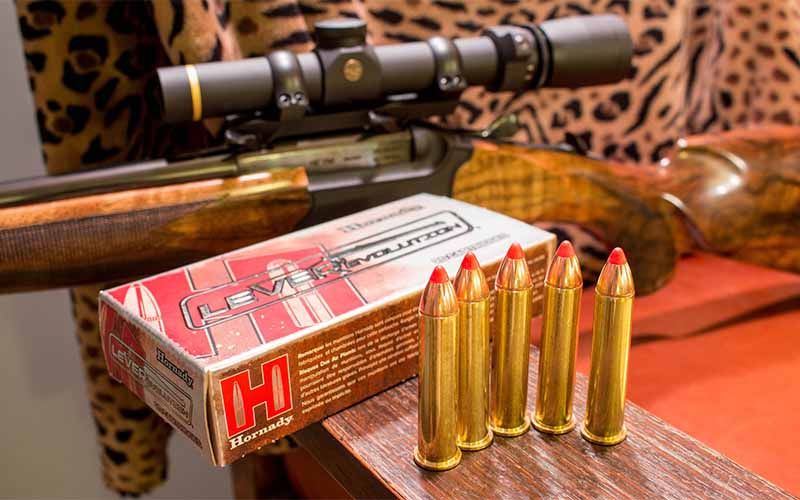
In older firearms, pressures need to be kept low, in deference to the metallurgy of the era. In modern firearms, the pressures and performance can be ramped up. Hornady’s LEVERevolution load uses a 325-grain FTX (Flex Tip eXpanding) bullet with its flexible polymer tip that allows the use of a spitzer bullet in a tubular magazine at a muzzle velocity of 2,050 fps, allowing a 200-yard zero to be employed and generating over 3,000 ft-lb of muzzle energy. Federal’s HammerDown line uses a bonded-core 300-grain soft-point at 1,850 fps, optimized for lever-action rifles by offering the best blend of expansion and penetration.
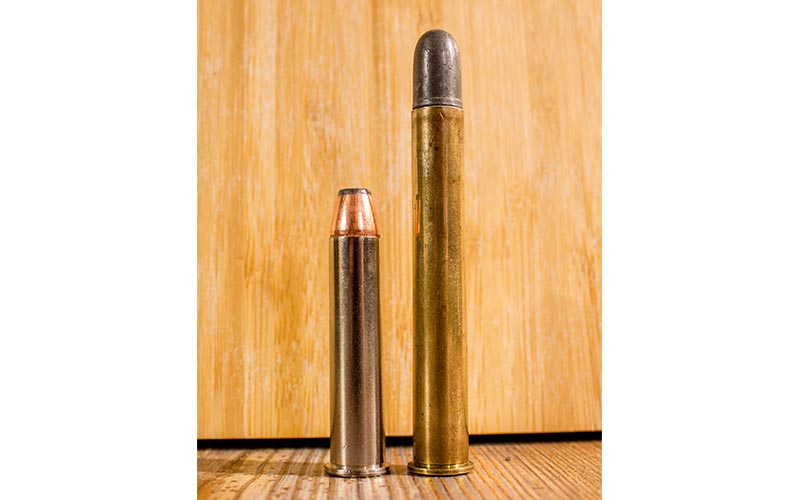
In the years following the release of the .45-70—which didn’t take long at all to make its way to the hunting field—there were variants with longer cases, such as the .45-90 Sharps (2.40-inch case), .45-100 (2.60-inch case), .45-110 (2⅞-inch case) and the .45-120 (3¼-inch case), all designed for the exploding buffalo market. The largest of the lot, the .45-120, didn’t hit the market until roughly 1880 when the game was pretty much over.
The .577/450 Martini Henry
Developed in the early 1870s—almost simultaneously with the .45-70 Government—the .577-450 was adopted as the standard issue for Her Majesty’s Army throughout the British Empire. Based on the .577 Snider, the Martini Henry featured a brass foil-wrapped case, which was easily dented and damaged. While not a true “stopping” cartridge, the .577-450 Martini Henry did play an important role in British military history—look up the Battle of Rorke’s Drift and the 1963 movie Zulu. The Martini Henry would drive a 480-grain bullet to a muzzle velocity of 1,350 fps.
The .450 3¼-inch Nitro Express
John Rigby’s 1898 release of the .450 Nitro Express set the benchmark for a dangerous game-stopping cartridge, arriving at a formula that’d be relied upon by both professional hunters and traveling sportsmen alike. The straight-walled, rimmed case was based on the earlier .450 Black Powder Express—which also used a 3¼-inch case and a .458-inch-diameter bullet—but used the new smokeless propellant.
The .450 NE used a 480-grain bullet, both soft-point and solid, at an advertised muzzle velocity of 2,150 fps for just under 5,000 ft-lb of muzzle energy—though we rather routinely discover that the ballistic values of that era were slightly exaggerated. Hunters found that the .458-inch-diameter bullets at that particular weight offered a wonderful blend of striking power and acceptable recoil, especially when compared to the .577 NE, 8- and 4-bore rifles. Famous hunters like Philip Percival, Denys Finch Hatton and John “Pondoro” Taylor relied on the .450 Nitro Express.
There were variants made shortly after the .450 NE saw the light of day, including Eley’s .450 No. 2, a bottleneck cartridge with a larger body and rim diameter and a 3½-inch case, and Holland & Holland’s .500/450, a bottleneck cartridge with a 3¼-inch case, made most famous in the hands of Theodore Roosevelt on his 1909 to 1910 safari. Both of these cartridges used a 480-grain bullet at 2,175 fps. Today, they’re both a rarity yet remain perfectly effective.
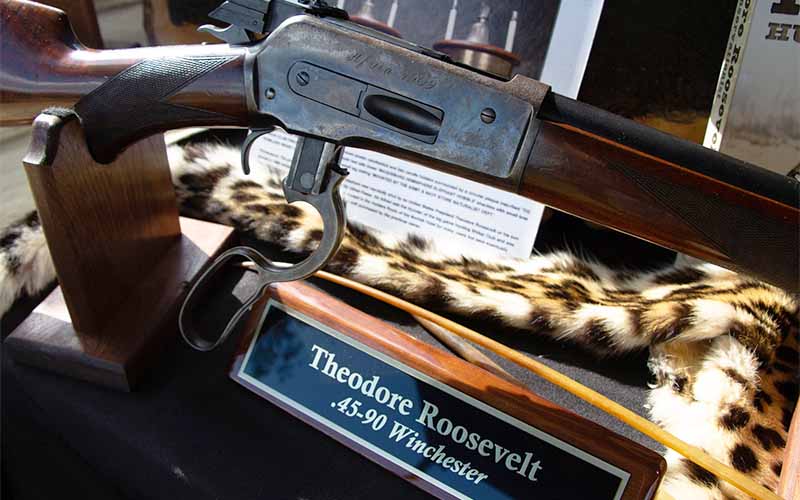
The insurrections in the British colonies of India and Sudan in the early 20th century caused the ban of all .45-caliber ammunition into those colonies in order to prevent the insurrectionists from obtaining projectiles for the .577/450 Martini Henry rifles they’d obtained. This led to the immediate development of cartridges of similar performance level but differing diameter, including the .470 NE, .475 NE, .475 No. 2 Jeffery’s, .476 NE and more. All use a bullet between 480 and 500 grains, and a muzzle velocity of 2,150 fps or thereabout, to replicate the .450 NE’s performance.
In the post-World War II era, supplies of sporting ammunition began to severely dwindle, although sportsmen began to travel abroad once again. Many of those beautiful double rifles sat in the rack with little or no ammunition to feed them, as Kynoch (the main supplier of British ammunition) began to cease production.
The .458 Winchester Magnum
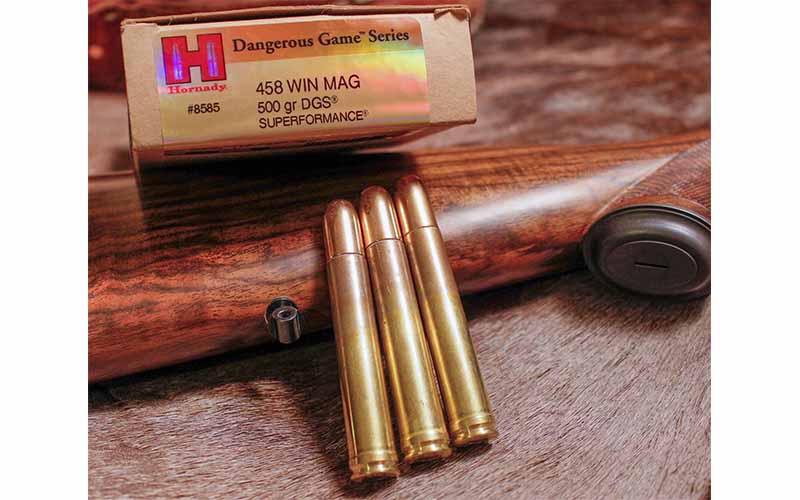
To fill that void left by Kynoch, Winchester set their engineers to work on developing an American cartridge that’d be available, affordable and effective. They began with the belted .375 H&H case, shortened it to 2.500 inches in order to fit in a long-action receiver, and took out the taper in order to hold a .458-inch-diameter bullet.
In 1956, the release of the .458 Winchester Magnum came, advertised to drive a 510-grain bullet to a muzzle velocity of 2,150 fps, to mimic the field performance of the .450 NE and .470 NE; the only issue was that the cartridge never met those values. The short case had a lack of powder capacity, and there were many instances of severely reduced velocities, extremely poor penetration, and caked-up powder charges; the early reputation of the cartridge wasn’t exactly fantastic.
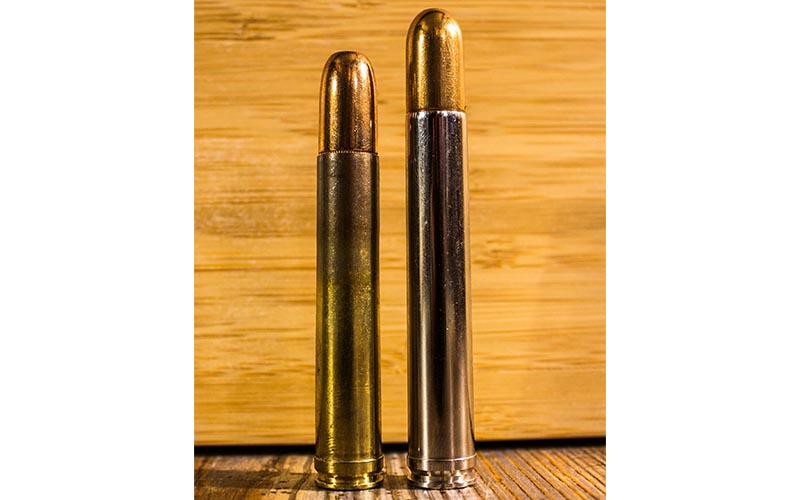
The modern iteration of the .458 Winchester Magnum has benefited from advancements in powder and the reduction in bullet weight from 510 to 500 grains, with factory ammo giving advertised velocities between 1,950 and 2,140 fps. Today’s .458 is an effective and reliable cartridge.
Because of the early issues with the .458 Win. Mag., there were several wildcat versions of the .458, using a longer case for additional powder capacity. There was the .450 Watts Magnum, using a .375 H&H-length straight-walled case at 2.850 inches, and the .450 Ackley Magnum at the same length but with the slightest shoulder introduced into the body.
But the success story of all the belted offspring of the .458 Winchester Magnum is the .458 Lott. Jack Lott had a bad experience with a wounded buffalo in Mozambique when using a .458 Winchester Magnum and set out to build a better mousetrap. Using the H&H belted case trimmed to 2.800 inches with no shoulder, the .458 Lott would give a velocity boost in comparison to the .458 Winchester Magnum. Factory loads have a 500-grain bullet leaving the muzzle at 2,300 fps for 5,872 ft-lb of energy at the muzzle.
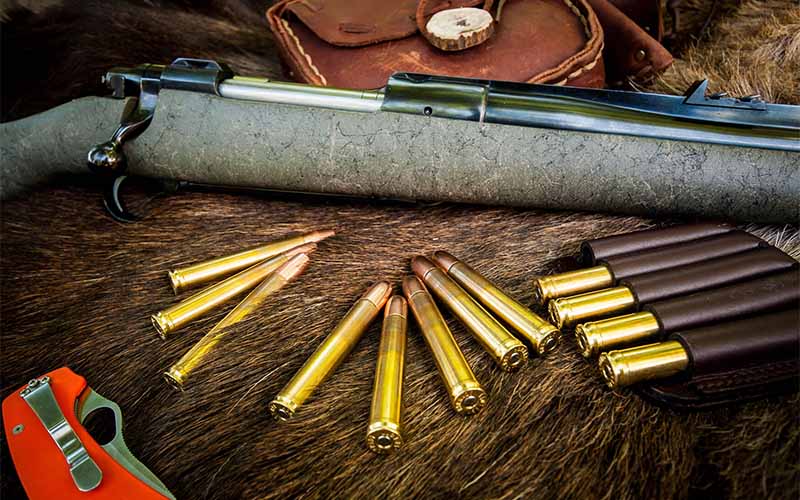
The .460 Weatherby Magnum
When Roy Weatherby reached for a new level of performance with his 1953 release of the .378 Weatherby Magnum (a case loosely based on a .416 Rigby but with a belt), I’m not sure that he immediately envisioned that case holding .458-inch-diameter slugs. Yet, just six years later, his .460 Weatherby Magnum would hit the market, assumedly in response to Winchester’s release of their .458 Magnum.
There was a wildcat version from a Montana gunsmith named John Buhmiller—he called it the .45 Weatherby—but Roy himself produced the cartridge commercially. Pushing a 500-grain bullet to 2,600 fps, the .460 Weatherby will generate over 7,500 ft-lb in modern ammunition and rifles. This does come at a price: The recoil of the .460 Weatherby has been described as hellacious and soul-crushing. The .460 has a long case, measuring 2.913 inches, and the overall length of 3.65 inches requires the use of a magnum-length action. Weatherby offer the pair of Hornady soft-point and solid bullets at 500 grains, and the lead-free Barnes TSX at 450 grains, the latter having a higher muzzle velocity of 2,700 fps.
The .460 Guns & Ammo
This is a bit of an oddball, which had a brief following in the 1970s and ’80s. Tom Siatos used the .404 Jeffery case, increased the shoulder angle to 15 degrees to improve headspacing while maintaining smooth feeding and necked the cartridge up to hold .458-inch-diameter bullets. With a muzzle velocity of 2,350 fps or so, it’s a bit hotter than the .458 Lott. However, it doesn’t have the case-stretching issues associated with belted cartridges, and like its parent cartridge, feeds wonderfully for a box magazine. Famed Botswana Professional Hunter Johan Calitz still enjoys his .460 G&A.
The .450 Rigby
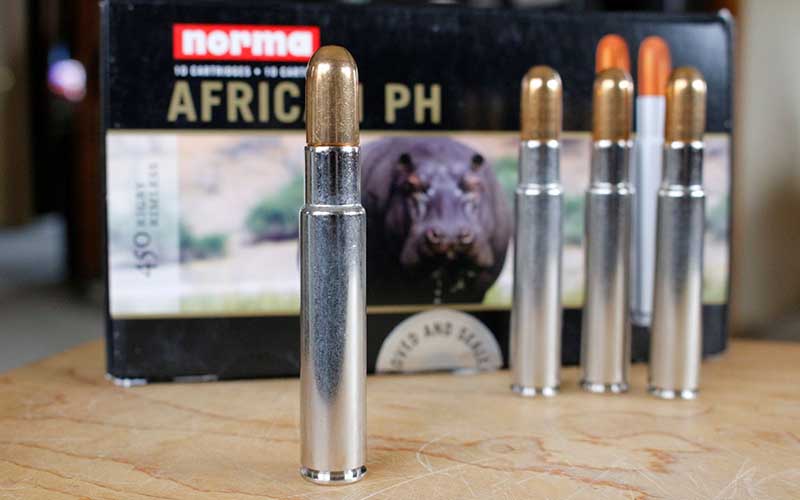
John Rigby & Co. have long been involved in dangerous game rifles and cartridges, with the .416 Rigby and .450 Nitro Express to their credit. In the early 1990s, Paul Roberts was at the helm of Rigby and, while on an elephant hunt, decided that their lineup needed a cartridge for a repeating rifle with more bullet weight and frontal diameter than the .416 Rigby offered. The solution was both simple and logical: neck up the .416 Rigby to use .458-inch-diameter bullets.
The .450 Rigby is a heavy-hitter, with factory loads delivering a 500-grain bullet at a muzzle velocity between 2,350 fps and 2,500 fps, depending on the brand, and Norma’s African PH ammo line offering a 550-grain Woodleigh Weldcore and FMJ solid at a muzzle velocity of 2,100 fps. Sharing the same 45-degree shoulder and rimless design of the .416 Rigby, the .450 Rigby offers a bit more muzzle energy and bullet weight, making it a better choice as a stopping rifle.
The .450 Marlin
The turn of the 21st century saw Marlin and Hornady pair up to develop a modernized version of the hot-rodded .45-70 loads on the market, designed for use in modern firearms with strong actions. While the .45-70 can be loaded to velocities far exceeding the capabilities of the Trapdoor rifles of the late 19th century, the .450 Marlin gives that level of performance without the possibility of using the wrong ammo in an older rifle.
Based on the .458×2-inch American cartridge—a shortened .458 Winchester Magnum case—the .450 Marlin wears a different belt than the traditional H&H to prevent it from being accidentally chambered in a .300 Winchester Magnum or 7mm Remington Magnum rifle, the results of which could be catastrophic. Hornady offers a 325-grain FTX bullet in their LEVERevolution line at a muzzle velocity of 2,225 fps for just over 3,500 ft-lb of energy, making an impressive lever gun, perfect for game with teeth and/or claws in thick cover, as well as larger game species inside of 300 yards.
The .458 SOCOM
For those who appreciate the AR platform, the .458 SOCOM is the cartridge that’ll offer a whole bunch of stopping power with rapid backup shots. Based on the .50 Action Express cartridge, the .458 SOCOM uses a rebated rim (measuring 0.473 inch, the same as the .308 Winchester family to fit the bolt face of the AR-10 rifle) and a case with minimal body taper and a very slight shoulder.
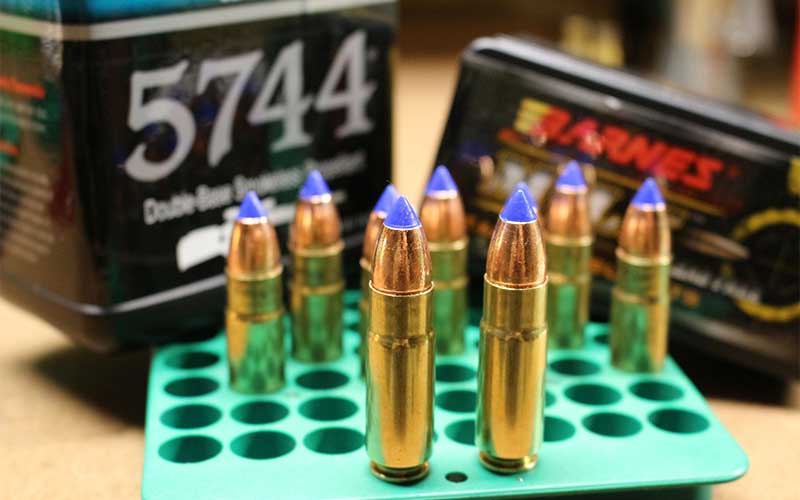
Pushing 300-grain bullet at a muzzle velocity of 1,900 fps, the .458 SOCOM turns a handy rifle into a big game stopper and has proven to be wonderfully accurate, as well as mild on the shoulder. For a projectile, I really like the 300-grain Barnes TTSX, as it has the integrity to handle the impact velocity of close shots, yet will open reliably at moderate ranges. If you want to turn your AR-10 into a rifle fully capable of handling the nastiest boar in the thick stuff, look to the .458 SOCOM to solve that issue.
Pick Your .45-Caliber Poison
While you’ll notice the majority of cartridges designed for the thick-skinned African game species center around the 500-grain bullets—and I’ll condone that choice based on the Sectional Density alone—and the American cartridges like the .45-70 and .450 Marlin use lighter projectiles, the frontal diameter alone of the .45s is an impressive factor in choosing a cartridge for game which can hurt you.
I’m also going to be completely honest and admit I’ve long been a proponent of cartridges in the lower .40s—including the .404 Jeffery and .416 Remington Magnum—for their blend of penetration, trajectory and energy values, but will admit that the .45-caliber bullets are better in the stopping department. There’s a reason that the .450 Nitro Express set the benchmark for dangerous game cartridges: a 458-inch-diameter bullet weighing between 480 and 510 grains at a muzzle velocity in the neighborhood of 2,100 to 2,300 fps just plain works, irrespective of species.
Editor's Note: This article originally appeared in the May 2022 issue of Gun Digest the Magazine.
More On .45-Caliber Guns, Ammo & Gear:
- Hard-Hitting .45-Caliber Hunting Revolver Cartridges
- Top 10 .45-Caliber Pistol Options For Any Budget
- The Elimin8r .45: Lone Wolf's .45-Caliber Suppressor
- The Sig Sauer MODX-45 .45-Caliber Pistol Suppressor

Next Step: Get your FREE Printable Target Pack
Enhance your shooting precision with our 62 MOA Targets, perfect for rifles and handguns. Crafted in collaboration with Storm Tactical for accuracy and versatility.
Subscribe to the Gun Digest email newsletter and get your downloadable target pack sent straight to your inbox. Stay updated with the latest firearms info in the industry.

![Best Concealed Carry Guns In 2025 [Field Tested] Wilson Combat EDC X9S 1](https://gundigest.com/wp-content/uploads/Wilson-Combat-EDC-X9S-1-324x160.jpg)


![Best 9mm Carbine: Affordable PCCs [Tested] Ruger Carbine Shooting](https://gundigest.com/wp-content/uploads/Ruger-Carbine-Shooting-100x70.jpg)
![Best AR-15: Top Options Available Today [Field Tested] Harrington and Richardson PSA XM177E2 feature](https://gundigest.com/wp-content/uploads/Harrington-and-Richardson-PSA-XM177E2-feature-100x70.jpg)

458 socom is used in ar15, not ar10. Also 450 bushmaster deserves attention as it prob is the best selling .45 in the past 5 years
I didn’t think I was recoil sensitive until I started reloading my 45-70 Marlin lever rifle.
Using my own cast & powder coated 340 grain RNFT bullet, I worked my way up from 35 grains of powder to 45 grains. I prefer a lighter, faster bullet for 45-70 so my goal was to drive my 340 grainer to 2000 FPS. Approaching 45 grains intensified the recoil unpleasantries so I settled on 40 grains of powder delivering 1600 FPs. A couple of failures to *fully tuck in* the rifle stung me & fully discouraged me from going over 40 grains. I shudder to think about driving a 405 or 500 grain bullet any faster than 1500 FPS. However, 45-70 is a very cool cartridge.
With attention to recoil mitigation, the .458 Magnum, using modern powders rather than those that early on gave it a bad reputation, is an excellent all-around cartridge. I had a rifle built around it back years ago – a full length bolt action, in a walnut Mannlicher (stocked to the muzzle) style stock with a heavy rollover cheek comb, a deep ventilated recoil pad, and Mag-na-Ported barrel. The comb is aggressively pitched downward from rear to front, so that recoil moves it away from the shooter’s head as the gun muzzle rises in recoil. It is very comfortable to shoot – far more so than, say, a .30-06 – with a low recoil velocity rearward “push” rather than a jolt, even with 500 grain bullets. At the current cost of commercial ammunition, your bank account runs out before your shoulder even notices you’ve been shooting. With reloads using .45 caliber sabots and lightweight .30 caliber bullets, it’s anything from a coyote to a whitetail rifle; you can also use 140 grain ARX composite bullets designed for .458 SOCOM without a sabot against a wide variety of intermediate-sized game, with recoil that’s unnoticeable. But you’ve always got grizzly-stopping power sitting in your pocket if needed. My favorite rifle.
May have already been corrected, the .458 SOCOM is fired thru the AR-15 platform, not the AR-10.